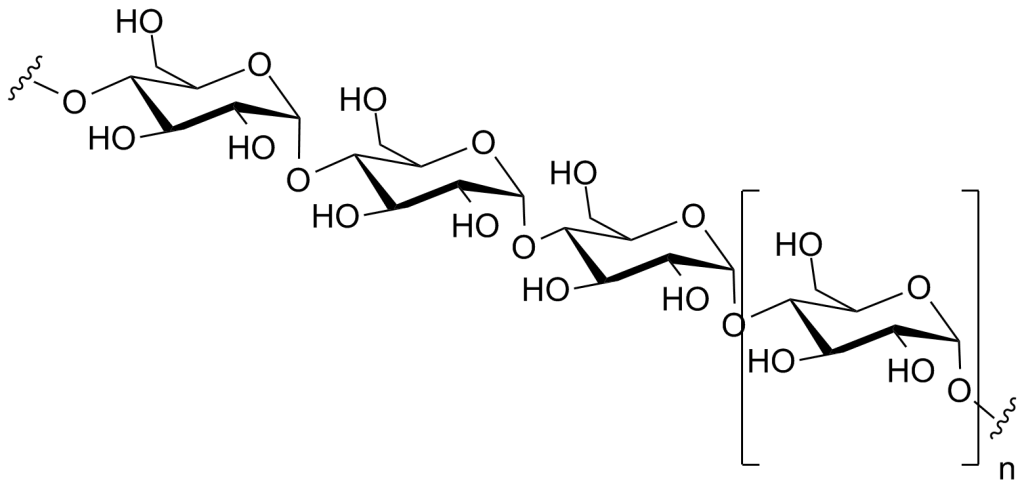Today is the first day of starch week on Beer and Wine Journal. (It’s like Shark Week on Animal Planet, but instead of ridiculous made-up crap about sharks, it’s facts about starch.) See the introduction to the series for an overview of the topics to be covered. Today’s post deals with amylose, one of the two main components of starch.

Glucose molecules joined in alpha 1 –> 4 linkages. In barley, amylose molecules typically range from 500 to 5,000 glucose residues.
The articles that compose this series on starch will have a few common themes. The most important is that the word starch refers to a variety of things, not a single, defined entity. For example, starch is composed of amylose and amylopectin. Any combination of these two molecules — from 1% amylose to 99% amylose — would be considered a starch, even though differing mixtures would have different properties.
Additionally, in real life situations, starches maybe complexed with proteins and other molecules. These other molecules can change the properties of the starch. Starch is also packed into different sized granules, which affects its solubility. Even heating and cooling starch can change its structure and its properties.
Glucose, The Subunit of Amylose

Glucose diagram, with carbons numbered. In this diagram, carbons are implied anywhere a line ends, bends, or intersects with another line, except if it ends in a letter or letters. (H = hydrogen, O = oxygen)
Amylose is made up of glucose molecules linked together. Glucose has six carbon atoms. Five of the six carbons, and an oxygen molecule, are arranged in a hexagonal ring. The sixth carbon molecule resides between carbon 5 (in the ring) and a hydroxyl group (—OH). Three of the carbon molecules, and the oxygen, are in the same plane. The remaining two carbons are bent away from the plane, in different directions, leaving a 3-dimensional structure that is sometimes described as a chair-like conformation. Glucose can also exist as a linear molecule in other situations.
Amylose

A depiction of the chair-like conformation of glucose. A boat-like structure — with both ends of the hexagon bent in the same direction — also exists.
Amylose is a molecule composed of 500 to 5,000 glucose molecules linked together from the first carbon atom of one glucose molecule to the fourth on another. In chemists lingo, it’s an alpha 1 —> 4 linkage. The carbon in the aldehyde group — in other words, the carbon connected to the oxygen molecule in the ring — is carbon 1. (The first diagram in the article shows four glucose molecules linked 1 to 4.)
The chemical reaction that adds new glucose molecules to a growing amylose chain occurs in the plant. For barley starch, obviously, the reaction occurs inside the barley kernel, specifically inside an organelle called an amyloplast. The reaction is catalyzed by a starch synthase enzyme, and requires the energy from one molecule ATP. A hydrogen from the hydroxyl group on carbon 1 and the hydroxyl group (—OH) on the 4th carbon of the other glucose molecule join to form a water (H2O) molecule, leaving the alpha 1—> 4 bond. As we will see, when starch is broken down, water is added to this bond, breaking it. Amylopectin is formed by a pathway containing multiple enzymes.
Amylose Forms a Helix In Solution
In an aqueous solution, amylose molecules form helixes. An amylose helix generally contains 8 glucose residues per turn, creating a structure somewhat like a tube or a straw. In barley, amylose helices typically contain 60 to 600 turns. If a solution contains iodine, amylose will bind tightly to the iodine, encompassing it within its tube. When this happens, the starch-iodine complex turns purple. In contrast, amylopectin — the other main component of starch — only weakly binds iodine to form a dull brown color. Another difference between amylose and amylopectin is that amylose is not very soluble in cold water. In other words, starch is composed of two components with different chemical properties.
Contrary to common wisdom, most amylose molecules do have a few side branches. Each molecule usually has 9 to 20 side chains, with the length of a side chains vary between 4 and over a 100 glucose residues. The side chains are connected to main amylose helix via an alpha 1—> 6 bond. Amylose in older starch granules tend to be more branched. Inside granules, amylose gets packed in — with it’s helices laying parallel to each other – much more densely than amylopectin.

An amylose helix with 63 glucose residues and 8 turns of the helix. In barley, typical helices are longer than depicted and contain the occasional side branch.
In summary, amylose is — along with amylopectin — one of the two components of starch. Amylose is a long chain of glucose residues, connected from carbon 1 on one glucose to carbon 4 on the next. The glucose residues form a helix with, on average, 8 residues per turn. They also contain a few side chains.
Amylose differs from amylopectin in many ways, including being less soluble and strongly binding iodine.
The next installment of this series will be posted on Thursday.
—
Related articles
Barley Starch for Brewers (I: Intro and Overview)
Tannins For Brewers (The Basics)

Hey Chris- Thanks for another well-written, bite-sized article for me to geek out on!
Not that it’ll ruin anyone’s wort, but I think you said iodine binds to amylase… instead of amylose…?
Whoops, yes. I initially wrote amylase (the enzyme) when I meant amylose (the carbohydrate). Fixed. Thanks.